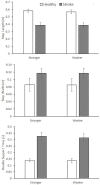Biomechanical Correlates of Falls Risk in Gait Impaired Stroke Survivors
- PMID: 35330930
- PMCID: PMC8940193
- DOI: 10.3389/fphys.2022.833417
Biomechanical Correlates of Falls Risk in Gait Impaired Stroke Survivors
Abstract
Increased falls risk is prevalent among stroke survivors with gait impairments. Tripping is the leading cause of falls and it is highly associated with mid-swing Minimum Foot Clearance (MFC), when the foot's vertical margin from the walking surface is minimal. The current study investigated MFC characteristics of post-stroke individuals (n = 40) and healthy senior controls (n = 21) during preferred speed treadmill walking, using an Optotrak 3D motion capture system to record foot-ground clearance. In addition to MFC, bi-lateral spatio-temporal gait parameters, including step length, step width and double support time, were obtained for the post-stroke group's Unaffected and Affected limb and the control group's Dominant and Non-dominant limbs. Statistical analysis of MFC included central tendency (mean, median), step-to-step variability (standard deviation and interquartile range) and distribution (skewness and kurtosis). In addition, the first percentile, that is the lowest 1% of MFC values (MFC 1%) were computed to identify very high-risk foot trajectory control. Spatio-temporal parameters were described using the mean and standard deviation with a 2 × 2 (Group × Limb) Multivariate Analysis of Variance applied to determine significant Group and Limb effects. Pearson's correlations were used to reveal any interdependence between gait variables and MFC control. The main finding of the current research was that post-stroke group's affected limb demonstrated lower MFC 1% with higher variability and lower kurtosis. Post-stroke gait was also characterised by shorter step length, larger step width and increased double support time. Gait retraining methods, such as using real-time biofeedback, would, therefore, be recommended for post-stroke individuals, allowing them to acquire optimum swing foot control and reduce their tripping risk by elevating the swing foot and improving step-to-step consistency in gait control.
Keywords: falls prevention; gait retraining; minimum foot clearance; stroke; tripping prevent.
Copyright © 2022 Nagano, Said, James, Sparrow and Begg.
Conflict of interest statement
The authors declare that the research was conducted in the absence of any commercial or financial relationships that could be construed as a potential conflict of interest.
Figures




Similar articles
-
Feasibility of Using Foot-Ground Clearance Biofeedback Training in Treadmill Walking for Post-Stroke Gait Rehabilitation.Brain Sci. 2020 Dec 13;10(12):978. doi: 10.3390/brainsci10120978. Brain Sci. 2020. PMID: 33322082 Free PMC article.
-
A cross-sectional study of foot-ground clearance in healthy community dwelling Japanese cohorts aged 50, 60 and 70 years.BMC Geriatr. 2021 Mar 6;21(1):166. doi: 10.1186/s12877-021-02117-w. BMC Geriatr. 2021. PMID: 33676395 Free PMC article.
-
Using Deep Learning to Predict Minimum Foot-Ground Clearance Event from Toe-Off Kinematics.Sensors (Basel). 2022 Sep 14;22(18):6960. doi: 10.3390/s22186960. Sensors (Basel). 2022. PMID: 36146308 Free PMC article.
-
A Scoping Review on Minimum Foot Clearance: An Exploration of Level-Ground Clearance in Individuals with Abnormal Gait.Int J Environ Res Public Health. 2021 Sep 29;18(19):10289. doi: 10.3390/ijerph181910289. Int J Environ Res Public Health. 2021. PMID: 34639597 Free PMC article.
-
A Scoping Review on Minimum Foot Clearance Measurement: Sensing Modalities.Int J Environ Res Public Health. 2021 Oct 15;18(20):10848. doi: 10.3390/ijerph182010848. Int J Environ Res Public Health. 2021. PMID: 34682592 Free PMC article.
Cited by
-
Autonomous Powered Ankle Exoskeleton Improves Foot Clearance and Knee Hyperextension After Stroke: A Case Study.IEEE Trans Med Robot Bionics. 2025 Feb;7(1):51-58. doi: 10.1109/tmrb.2024.3503893. Epub 2024 Nov 21. IEEE Trans Med Robot Bionics. 2025. PMID: 40182232 Free PMC article.
-
Predicting improvement in biofeedback gait training using short-term spectral features from minimum foot clearance data.Front Bioeng Biotechnol. 2024 Aug 28;12:1417497. doi: 10.3389/fbioe.2024.1417497. eCollection 2024. Front Bioeng Biotechnol. 2024. PMID: 39262630 Free PMC article.
-
Application of Isokinetic Dynamometry Data in Predicting Gait Deviation Index Using Machine Learning in Stroke Patients: A Cross-Sectional Study.Sensors (Basel). 2024 Nov 13;24(22):7258. doi: 10.3390/s24227258. Sensors (Basel). 2024. PMID: 39599035 Free PMC article.
References
-
- Australian Institute of Health and Welfare (2020). Stroke. Available at: https://www.aihw.gov.au/reports/australias-health/stroke (Accessed August 20, 2020).
LinkOut - more resources
Full Text Sources

